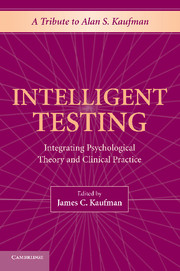Book contents
- Frontmatter
- Contents
- Acknowledgments
- Alphabetical List of Authors and Affiliations
- PART ONE THOSE WHO KNOW HIM
- PART TWO INTELLIGENT TESTING
- PART THREE THE INTERSECTION OF THEORY AND MEASUREMENT
- 8 Kaufman on Theory, Measurement, Interpretation, and Fairness: A Legacy in Training, Practice, and Research
- 9 The Theory of Successful Intelligence as a Basis for New Forms of Ability Testing at the High School, College, and Graduate School Levels
- 10 Kaufman's Work in the Penumbra between Measurement Science and Clinical Assessment
- 11 Success Is a Latent Variable: How Alan Kaufman Shaped Intelligence Test Theory, Interpretation, and Psychometrics with Factor Analysis
- PART FOUR KAUFMAN ACROSS THE WORLD
- Author Index
- Subject Index
- References
11 - Success Is a Latent Variable: How Alan Kaufman Shaped Intelligence Test Theory, Interpretation, and Psychometrics with Factor Analysis
Published online by Cambridge University Press: 05 August 2012
- Frontmatter
- Contents
- Acknowledgments
- Alphabetical List of Authors and Affiliations
- PART ONE THOSE WHO KNOW HIM
- PART TWO INTELLIGENT TESTING
- PART THREE THE INTERSECTION OF THEORY AND MEASUREMENT
- 8 Kaufman on Theory, Measurement, Interpretation, and Fairness: A Legacy in Training, Practice, and Research
- 9 The Theory of Successful Intelligence as a Basis for New Forms of Ability Testing at the High School, College, and Graduate School Levels
- 10 Kaufman's Work in the Penumbra between Measurement Science and Clinical Assessment
- 11 Success Is a Latent Variable: How Alan Kaufman Shaped Intelligence Test Theory, Interpretation, and Psychometrics with Factor Analysis
- PART FOUR KAUFMAN ACROSS THE WORLD
- Author Index
- Subject Index
- References
Summary
Kaufman (1990) has noted that there seems nothing more irresistible to a psychometrician than factor analysis of an IQ test. I certainly fall into that category, and therefore jumped at the opportunity to provide a chapter on Alan's influence on and with factor analysis for this book. The Kaufman Intelligent Testing system is one of the most widely used tools in cognitive assessment, which essentially mandates assessors validate the use of factors for each person they assess. I therefore do not find it an overstatement to say that Alan Kaufman's imprint on cognitive assessment with and on factor analysis is not only veritably omnipresent, but perhaps unparalleled.
Before I get too carried away discussing how Kaufman has used and refined factor analysis to the benefit of the study of cognitive assessment, I feel it appropriate to begin with a limitation. Above all, Kaufman places the most emphasis on understanding the person behind the test scores rather than the interrelationships among the measures used. “Many psychological reports stress what the scales or subtests measure instead of what aspects of the person are particularly well developed or in need of improvement; many reports are so number-oriented that the reader loses sight of the person's uniquenesses” (Kaufman & Lichtenberger, 2006, p. 22). Hence, part of the intelligent testing system of interpreting results from an IQ test is to assure that the person is always the center of attention, not the psychometrics.
- Type
- Chapter
- Information
- Intelligent TestingIntegrating Psychological Theory and Clinical Practice, pp. 157 - 170Publisher: Cambridge University PressPrint publication year: 2009



